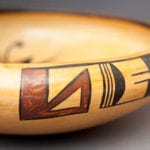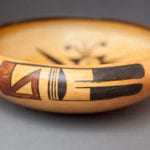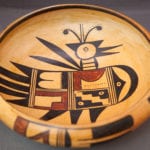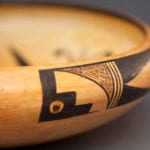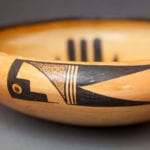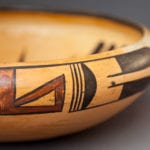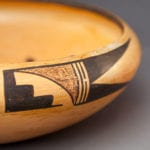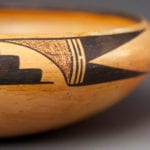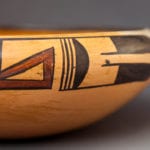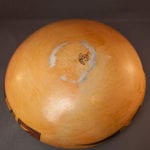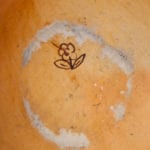This bowl displays a proud and attentive folk art bird that seems derived from traditional Acoma bird design. Variations of this theme are found on other Hopi pots. (See Folk Art Bird Design in the Category List.)
The vessel is flat-bottomed and the sides curve outward until about an inch below the rim. Then they curve sharply inward forming an internal lip. The walls are even and substantial, but not thick. Just to the right of the right foot of the bird is a crack that extends upward to the edge of the bowl and is spidered on the external surface. The outdoor firing produced a fairly even color without dramatic blushing.
He bowl is signed with a five-peddle flower rising above two leaves, the classic mark of Sadie Adams (1905-1995). She made pots for half a century beginning in the 1930’s and often demonstrated at the Museum of Northern Arizona.
Except for two central red elements, the bird is monochromatic. As detailed below, much of the visual power of the pot derives from unpainted designs embedded in painted areas, a sophisticated technique that attests to the skill of the artist
A large tapered “D” delineates the breast. Behind it is painted broad-based triangle stood on its end, pointed right and with slightly curved sides. Between this element and the “D” is an unpainted area with the residual shape of two leaves pointed toward the rear.
Behind these elements is a vertical space enclosing four lines, thus forming a three-lane highway.
To the left are two sections of design, separated from each other and the tail by two additional renditions of this highway,
Each of these two sections contains lower and upper squares. The top right section of the four has a solid red form in the shape of a drape of cloth ending in a straight fall. The rest of this quadrant is unpainted except for a horizontal row of nine black dots. The square below has two stepped cloud images in black, the bottom one with the lower step toward the front, the upper drawn with this step toward the rear. The residual unpainted area between these elements represents stepped lightening.
The bottom rear section of the four squares is solid red except that the center is unpainted and forms a one-stepped cloud image. Above it is a solid black square, save that much of the center is unpainted and forms a double-lobed form facing toward the rear. Eight short lines emerge from its base and intrude into the unpainted space. Thus the upper left and lower right quadrants of the central core are painted black while the upper right and lower left quadrants display red paint.
Unpainted cores define all four squares and help the assemblage cohere. The two colors and the varying central motifs attract a viewer’s eye on this core of the bird.
Rising above this core is a three-segment neck and a head with an unpainted eye centered on a circular iris, flat-topped crest and a segmented beak. Two antennas crown the head and are encircled by 16-17 dots. Emerging from the rear base of the neck are two petal forms. These may signify that we are seeing a mythical being. Schaafsma (2010:32) interprets them as paaho (prayer feathers) and they are found on two other pots in this collection: Nampeyo’s early Acoma-bird pot (2015-03) and a Polacca pot with quadrupeds (2011-07).
The tail of the bird is monochromatic and reminds me of a jet afterburner propelling the bird forward with great speed: two right angle triangles frame three linear black tails.
Notice that the form of the circular eye is echoed by three circular images imbedded in different black areas of the bird’s core, thus unifying elements that form the interior bird.
Like Nampeyo, Sadie Adams has left substantial unpainted surface around the interior design and this surface links with the unpainted areas in the design to highlight the bird.
The exterior of the bowl features two glyphs, each repeated two times.
Think of the first glyph as headed by a right angled triangle with its short right side vertical and resting on its long side. Emerging upward from and obliterating the left point is a thick bar. Only this section of the glyph is drawn with red paint. Behind it is the familiar three-lane highway motif followed by a solid half moon. Forming the rear of the glyph are two feathers with unpainted bases and long black tips. The identical glyph is repeated on the opposite exterior of the bowl.
The second glyph is monochromatic, its head a two-stepped cloud image pointing toward the rear. This form hangs from the point of a stippled triangular shape. The center of this glyph is the familiar three-lane highway, followed by two solid-black triangular feathers forming a V-shaped tail.
The center of this tail is filled with the unpainted surface of the bowl, creating a triangle that contradicts the backward thrust of the painted tails. This glyph is repeated on the opposite side of the bowl, except that in one rendition the leading stepped element is solid black while on the other this element has an embedded circular eye.
This slight variation suggests to me that Sadie was following a pattern seen in her mind’s eye and painted what she imagined, since one side of the bowl is not visible when painting the other side. She was not worried about an exact duplication of the two designs. Today’s younger Hopi potters who tend to produce perfectly-designed, high-end pottery avoid such casual variation. On the other hand, the single circular eye on the exterior of the bowl reflects the same image painted three times on the interior design, thus subtly linking interior and exterior. Perhaps this variation is intentional; I can’t know. The creative process keeps some of itself hidden.
Whereas visual variation on the first glyph is provided by the use of color, the second glyph is enlivened by use of a stippled central section. While the two glyphs are quite different, they share the central two-lane highway and both have black tails. The two linear tails of the first glyph are similar to the central feathers of the interior bird. The two tails on the second glyph are identical to the outermost elements of the tail of the interior bird. Such variations of design amid a unifying theme are the hallmark of a master potter.


